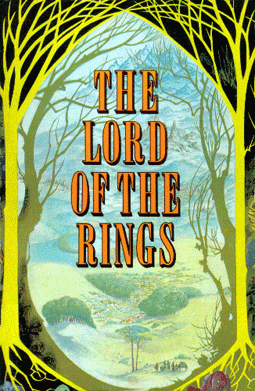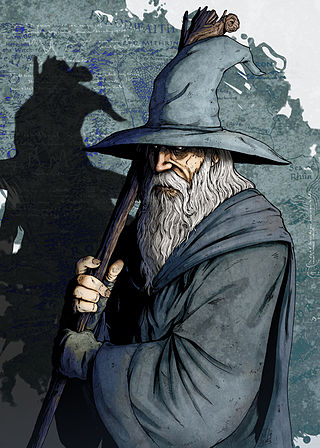
The Lord of the Rings is an epic high fantasy novel by the English author and scholar J. R. R. Tolkien. Set in Middle-earth, the story began as a sequel to Tolkien's 1937 children's book The Hobbit, but eventually developed into a much larger work. Written in stages between 1937 and 1949, The Lord of the Rings is one of the best-selling books ever written, with over 150 million copies sold.

Tom Bombadil is a character in J. R. R. Tolkien's legendarium. He first appeared in print in a 1934 poem called "The Adventures of Tom Bombadil", which also included The Lord of the Rings characters Goldberry, Old Man Willow and the barrow-wight, from whom he rescues the hobbits. They were not then explicitly part of the older legends that became The Silmarillion, and are not mentioned in The Hobbit.
Radagast the Brown is a fictional character in J. R. R. Tolkien's legendarium. A wizard and associate of Gandalf, he appears briefly in The Hobbit, The Lord of the Rings, The Silmarillion, and Unfinished Tales.
Treebeard, or Fangorn in Sindarin, is a tree-giant character in J. R. R. Tolkien's The Lord of the Rings. He is an Ent and is said by Gandalf to be "the oldest living thing that still walks beneath the Sun upon this Middle-earth." He lives in the ancient Forest of Fangorn, to which he has given his name. It lies at the southern end of the Misty Mountains. He is described as being about 14 feet in height, and in appearance similar to a beech or an oak.
In the fantasy of J. R. R. Tolkien, the Dwarves are a race inhabiting Middle-earth, the central continent of Arda in an imagined mythological past. They are based on the dwarfs of Germanic myths who were small humanoids that lived in mountains, practising mining, metallurgy, blacksmithing and jewellery. Tolkien described them as tough, warlike, and lovers of stone and craftsmanship.

Arwen Undómiel is a fictional character in J. R. R. Tolkien's Middle-earth legendarium. She appears in the novel The Lord of the Rings. Arwen is one of the half-elven who lived during the Third Age; her father was Elrond half-elven, lord of the Elvish sanctuary of Rivendell, while her mother was the Elf Celebrian, daughter of the Elf-queen Galadriel, ruler of Lothlórien. She marries the Man Aragorn, who becomes King of Arnor and Gondor.
Gil-galad is a fictional character in J. R. R. Tolkien's Middle-earth legendarium, the last high king of the Noldor, one of the main divisions of Elves. He is mentioned in The Lord of the Rings, where the hobbit Sam Gamgee recites a fragment of a poem about him, and The Silmarillion. In the Last Alliance of Elves and Men, Gil-galad and Elendil laid siege to the Dark Lord Sauron's fortress of Barad-dûr, and fought him hand-to-hand for the One Ring. Both Gil-galad and Elendil were killed, and Elendil's son Isildur took the Ring for himself. Gil-galad briefly appears at the opening of Peter Jackson's The Lord of the Rings film trilogy, and in several video games based on Tolkien's Middle-earth.

Brian David Sibley is an English writer. He is author of over 100 hours of radio drama and has written and presented hundreds of radio documentaries, features and weekly programmes. He is widely known as the author of many film "making of" books, including those for the Harry Potter series and The Lord of the Rings and The Hobbit trilogies.

John Howe is a Canadian book illustrator and concept designer, best-known for his artwork of J. R. R. Tolkien's Middle-earth. One year after graduating from high school, he studied in a college in Strasbourg, France, then at the École des arts décoratifs in the same town.
Trolls are fictional characters in J. R. R. Tolkien's Middle-earth, and feature in films and games adapted from his novels. They are portrayed as monstrously large humanoids of great strength and poor intellect. In The Hobbit, like the dwarf Alviss of Norse mythology, they must be below ground before dawn or turn to stone, whereas in The Lord of the Rings they are able to face daylight.
Balin is a fictional character in J. R. R. Tolkien's world of Middle-earth. A Dwarf, he is an important supporting character in The Hobbit, and is mentioned in The Fellowship of the Ring. As the Fellowship travel through the underground realm of Moria, they find Balin's tomb and the Dwarves' book of records, which tells how Balin founded a colony there, becoming Lord of Moria, and that the colony was overrun by orcs.
The production of The Lord of the Rings film series posed enormous challenges, both logistical and creative. Under Peter Jackson's direction, these obstacles were overcome between 1997 and 2004. Many attempts to produce J. R. R. Tolkien's fantasy novel The Lord of the Rings had failed; the few that had reached the screen were animations. Since the publication of the source novels in the mid-1950s, many filmmakers and producers had considered a film but then set the project aside. The series as filmed by Jackson consists of three epic fantasy adventure films. They were produced by New Line Cinema, assisted by WingNut Films. The cinema versions appeared between 2001 and 2003, and the extended edition for home video in 2004. Development began in August 1997. The films were shot simultaneously. Their production was undertaken entirely in Jackson's native New Zealand. It spanned the 14-month period from October 1999 until December 2000, with pick-up shots filmed over a further 24 months, from 2001 to 2003.

Saruman, also called Saruman the White, later Saruman of Many Colours, is a fictional character in J. R. R. Tolkien's fantasy novel The Lord of the Rings. He is leader of the Istari, wizards sent to Middle-earth in human form by the godlike Valar to challenge Sauron, the main antagonist of the novel, but eventually he desires Sauron's power for himself and tries to take over Middle-earth by force from his base at Isengard. His schemes feature prominently in the second volume, The Two Towers; he appears briefly at the end of the third volume, The Return of the King. His earlier history is summarised in the posthumously published The Silmarillion and Unfinished Tales.
Gimli is a fictional character in J. R. R. Tolkien's Middle-earth, appearing in The Lord of the Rings. A dwarf warrior, he is the son of Glóin, a member of Thorin's company in Tolkien's earlier book The Hobbit. He represents the race of Dwarves as a member of the Fellowship of the Ring. As such, he is one of the primary characters in the story. In the course of the adventure, Gimli aids the Ring-bearer Frodo Baggins, participates in the War of the Ring, and becomes close friends with Legolas, overcoming an ancient enmity of Dwarves and Elves.
Meriadoc Brandybuck, usually called Merry, is a Hobbit, a fictional character from J. R. R. Tolkien's Middle-earth legendarium, featured throughout his most famous work, The Lord of the Rings. Merry is described as one of the closest friends of Frodo Baggins, the main protagonist. Merry and his friend and cousin, Pippin, are members of the Fellowship of the Ring. They become separated from the rest of the group and spend much of The Two Towers making their own decisions. By the time of The Return of the King, Merry has enlisted in the army of Rohan as an esquire to King Théoden, in whose service he fights during the War of the Ring. After the war, he returns home, where he and Pippin lead the Scouring of the Shire, ridding it of Saruman's influence.
Théoden is a fictional character in J. R. R. Tolkien's fantasy novel, The Lord of the Rings. The King of Rohan and Lord of the Mark or of the Riddermark, names used by the Rohirrim for their land, he appears as a supporting character in The Two Towers and The Return of the King. When first introduced, Théoden is weak with age and sorrow and the machinations of his top advisor, Gríma Wormtongue, and he does nothing as his kingdom is crumbling. Once roused by the wizard Gandalf, however, he becomes an instrumental ally in the war against Saruman and Sauron, leading the Rohirrim into the Battle of the Pelennor Fields.
Mirkwood is a name used for a great dark fictional forest in novels by Sir Walter Scott and William Morris in the 19th century, and by J. R. R. Tolkien in the 20th century. The critic Tom Shippey explains that the name evoked the excitement of the wildness of Europe's ancient North.
Legolas is a fictional character in J. R. R. Tolkien's The Lord of the Rings. He is a Sindar Elf of the Woodland Realm and son of its king, Thranduil, becoming one of the nine members of the Fellowship who set out to destroy the One Ring. Though Dwarves and Elves are traditionally rivals, he and the Dwarf Gimli form a close friendship during their travels together.

The Wizards or Istari in J. R. R. Tolkien's fiction were powerful angelic beings, Maiar, who took the form of Men to intervene in the affairs of Middle-earth in the Third Age, after catastrophically violent direct interventions by the Valar, and indeed by the one god Eru Ilúvatar, in the earlier ages.